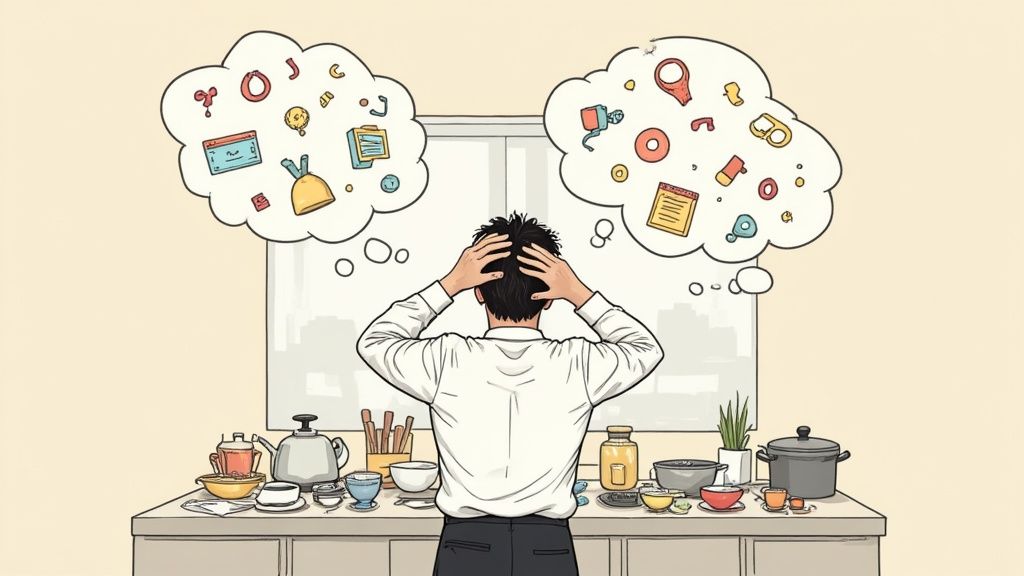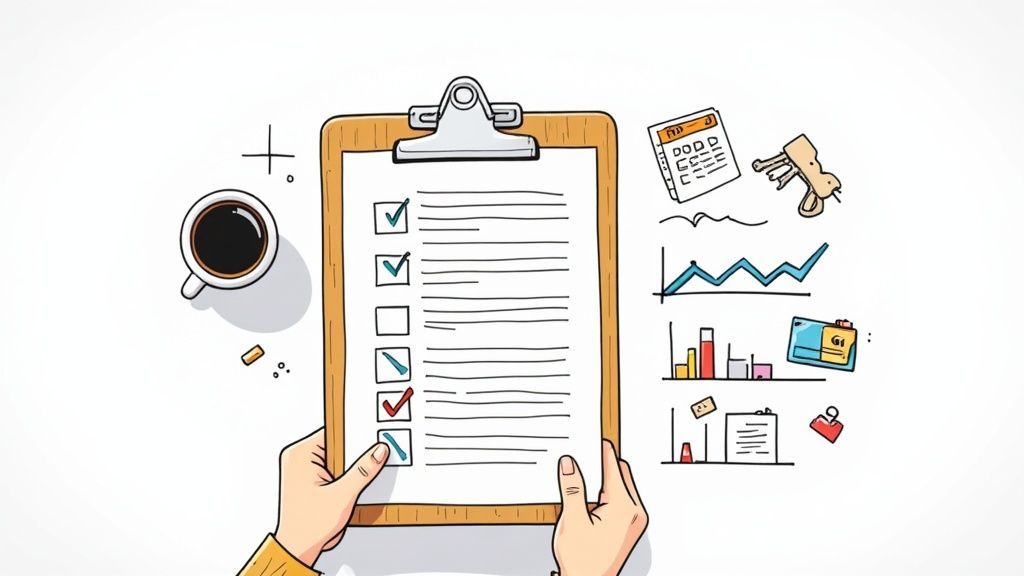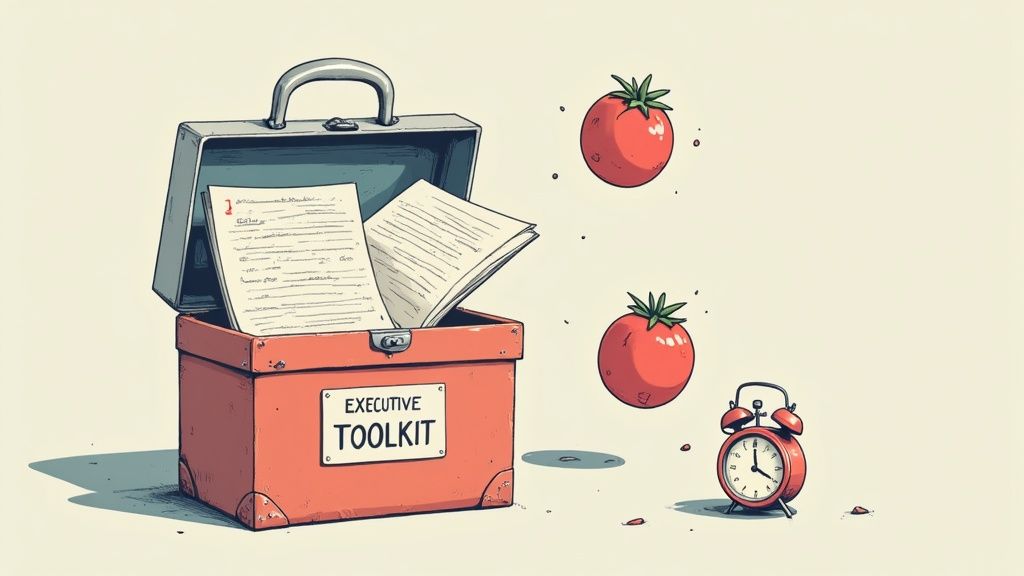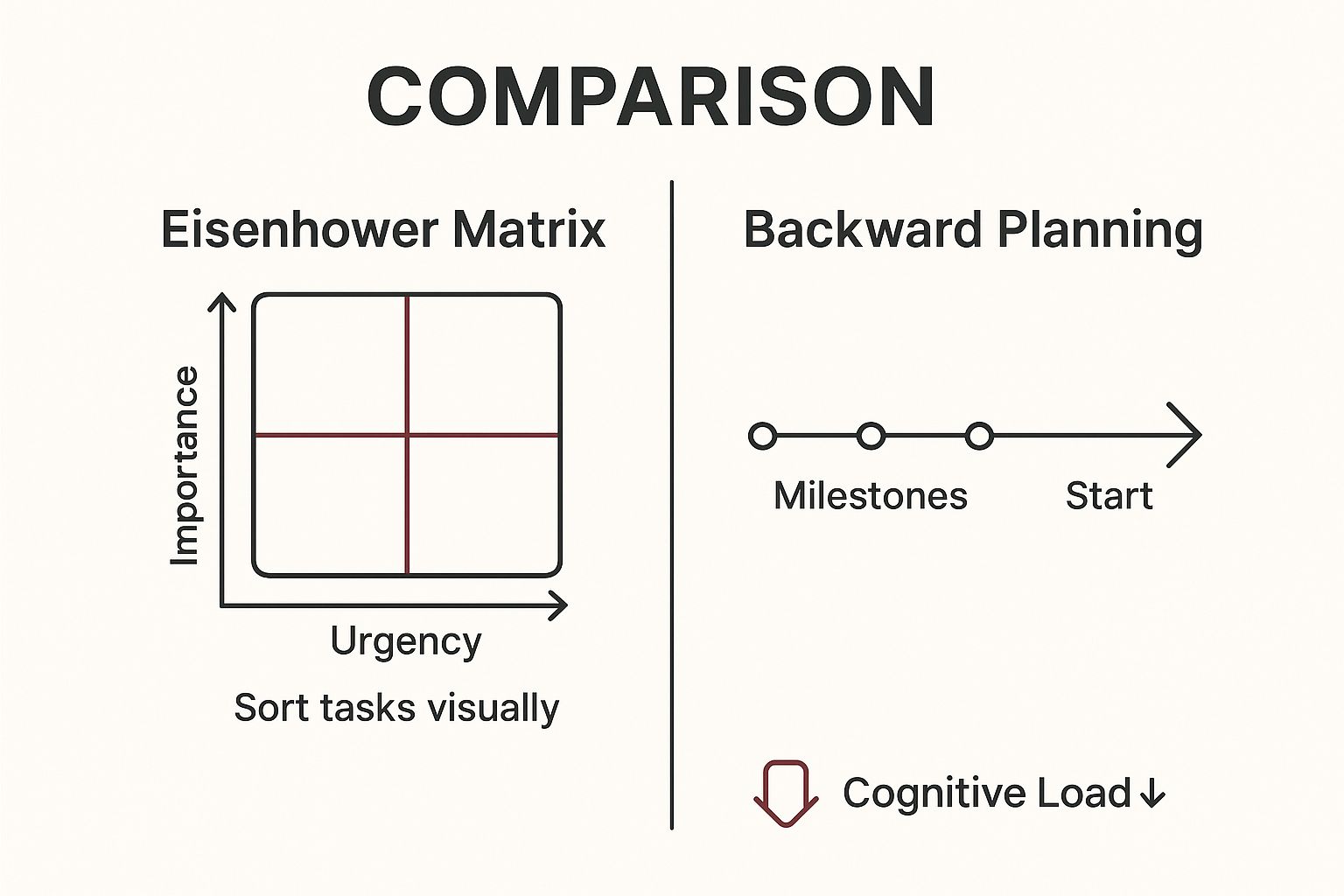If you feel like you’re constantly fighting your own brain just to get things done, you are definitely not alone. Getting executive function help as an adult isn't about some massive overhaul of who you are. It’s about learning practical, real-world strategies to manage the mental skills that control your planning, focus, and self-control.
It really comes down to building systems that support how you get things done, not just what you're doing.
What Executive Function Challenges Look Like for Adults

Think of executive functions as your brain's CEO or air traffic controller. These high-level mental skills are in charge of organizing, planning, and actually doing the tasks. When they're running smoothly, you can move through your day with a sense of control. But when they're not, life feels like a constant, frustrating uphill battle.
And let's be clear: these struggles are so much more than simple forgetfulness or a bit of procrastination. They show up in very specific, often maddening, ways that can take a real toll on your career, relationships, and even how you feel about yourself.
Common Signs of Executive Dysfunction
It's one thing to have an "off day" where nothing seems to click. It's something else entirely to face persistent patterns that constantly derail your life. So many adults wrestle with these challenges without ever realizing they're connected to executive function.
Spotting these patterns is the first, most powerful step toward getting the right kind of support. Here are a few scenarios that might feel a little too familiar:
- Analysis Paralysis: Standing in a messy kitchen, feeling so overwhelmed by the chaos that you just can't figure out where to start. The sheer number of steps—clearing counters, loading the dishwasher, wiping everything down—feels like an impossible mountain to climb.
- Time Blindness: You sit down to answer just one "quick" email. The next time you look up, two hours have vanished, and you've completely missed an important meeting.
- Emotional Dysregulation: A small, unexpected hiccup in your plans, like a friend running late, triggers a massive wave of frustration or anger that feels completely out of proportion to the situation.
- Task Initiation Difficulty: You know you have to start that critical project for work. You really know it. But instead, you spend hours tidying your desk or sorting emails, unable to bridge the gap between knowing and doing.
These aren't character flaws. They are not signs of laziness. They are symptoms of a cognitive system that's being pushed to its limits. Seeing them as skill-based challenges, rather than moral failings, is the key to making real progress.
Let’s break down some of these core skills and what it looks like when they’re under strain.
Common Executive Function Challenges and Real-Life Examples
| Executive Function Skill | What It Means | Common Adult Struggle Example |
|---|---|---|
| Working Memory | Holding and using information in your mind for short periods. | Forgetting what you walked into a room to get; losing your train of thought mid-sentence. |
| Inhibitory Control | Resisting impulses and distractions to stay on task. | Compulsively checking your phone notifications instead of finishing a report. |
| Cognitive Flexibility | Shifting your thinking from one concept to another; adapting to change. | Feeling intense frustration when a plan changes unexpectedly or struggling to switch from one task to another. |
| Planning/Prioritization | Creating a roadmap to achieve a goal and deciding what's most important. | Feeling overwhelmed by a large project and not knowing which part to tackle first. |
| Task Initiation | The ability to begin a task without procrastinating. | Knowing you need to make a phone call but putting it off for days or weeks. |
| Emotional Control | Managing your feelings and keeping them in check. | Having an outburst of anger over a minor inconvenience. |
Recognizing your specific struggle is the first step. Once you can name it, you can start to find the right strategy to manage it.
How Stress and Life Stages Play a Role
Stress is a massive amplifier for any existing executive function difficulties. When you're burned out, anxious, or just plain exhausted, your brain’s resources are directed toward survival, not high-level planning. This makes it infinitely harder to focus, organize, and manage your impulses.
Major life transitions are another huge factor. Starting a new job, becoming a parent, or dealing with a health issue all place immense demands on these skills.
On top of that, natural aging influences our cognitive abilities. Research has shown a well-documented decline in skills like inhibitory control as we get older, even in healthy adults. For a deeper dive, you can explore the research on how aging affects executive functions.
When you combine this normal process with everyday stressors, tasks that used to be easy can suddenly feel monumental. The goal isn’t to turn back the clock, but to build smarter, more compassionate systems to support your brain exactly where it is today.
Pinpoint Your Personal Executive Function Hurdles
Before you can start building better strategies, you have to know what you’re working with. Think of it like creating a personal map of your brain's unique operating system. Without it, you're just guessing, trying random fixes without understanding the real problem.
This isn’t about self-diagnosis. It’s about gaining clarity. The goal is to identify your specific profile—your strengths and, more importantly, your recurring pain points. An honest look at your daily patterns is the most valuable data you can get.
Start with Reflective Questions
Take a moment for a candid self-assessment. There are no right or wrong answers here, only insights. To get the ball rolling, try asking yourself a few pointed questions:
- How often do I misplace essential items like my keys, wallet, or phone in a single week?
- On a scale of 1-10, how well can I resist the impulse to check my phone when I'm supposed to be focused on something else?
- When I’m faced with a large project, does my mind go blank, or can I immediately see the first few steps?
- How frequently do I end up running late because I misjudged how long an activity would take?
For a more structured approach, you could explore an executive skills questionnaire. These tools can guide you through a more detailed reflection and give you a clearer picture of which skills need the most support.
Pinpointing your specific hurdles—whether it's getting started, managing frustration, or staying on track—is the most critical step. A vague sense of being "disorganized" isn't actionable, but knowing you struggle with task initiation is.
Connecting Patterns to Daily Life
These questions aren't just random queries; they help you spot the patterns. Executive functions like inhibitory control and working memory are the bedrock skills for self-regulation and hitting your goals.
When these skills are strained, the ripple effects can touch everything from your mental health to daily productivity. In fact, research shows that challenges in these functions are connected to a range of difficulties affecting nearly 10% of the global population.
For instance, constantly losing your keys might point to a snag in your working memory. Not being able to resist checking your phone highlights a challenge with inhibitory control.
Once you connect these dots, you can stop blaming yourself for being "lazy" or "messy." Instead, you can start building a targeted plan that addresses the real challenge at hand.
Actionable Habits for Your Executive Function Toolkit
Now that you have a clearer picture of your specific challenges, it's time to build a toolkit of practical, sustainable habits. Real executive function help for adults isn't about finding a single magic bullet. It's about creating a personalized system of small, manageable supports that work for your brain, not against it.
Let's move past vague advice like "just be more organized." We’re going to focus on field-tested techniques you can start using immediately, even on your most scattered days.
Tame Time and Sharpen Focus
One of the biggest hurdles is often wrestling with time and focus. Our brains can struggle to perceive the passage of time or maintain concentration on a single task, especially if it isn't immediately rewarding. The secret is to externalize these functions using simple, reliable tools.
The Pomodoro Technique is a classic for a reason. You simply break down work into focused, 25-minute intervals separated by short breaks. This method isn't just about managing time; it's about managing your energy and making daunting tasks feel approachable.
For example, instead of facing a massive report with dread, you just commit to one 25-minute "Pomodoro." A visual timer sitting on your desk can make this incredibly effective, transforming an abstract concept like "time" into something concrete you can see.
Clear the Mental Clutter
Think of your working memory like a computer's RAM—it has a limited capacity. When it's overloaded with stray thoughts, to-do items, and worries, there's no room left for deep focus or problem-solving. This is where a regular "Brain Dump" comes in.
This is more than just another to-do list. It's the practice of getting every single thought out of your head and onto paper or a digital document.
- Worries and anxieties? Write them down.
- Ideas for a future project? Get them out.
- That random thing you need to buy? Add it to the list.
- Frustrations from a meeting? Vent it onto the page.
By externalizing these thoughts, you free up critical mental bandwidth. You don't have to act on everything you write down; the goal is simply to clear the cache so your brain can operate more smoothly. It’s a simple yet powerful way to reduce that feeling of constant internal chaos.
A Brain Dump isn't about creating another overwhelming list of tasks. It's about giving your thoughts a designated place to live outside of your head, reducing the cognitive load required to simply remember everything.
Defeat Procrastination with Small Wins
For many adults struggling with executive function, the hardest part is just getting started. Task initiation can feel like hitting an invisible wall. This is where the Two-Minute Rule becomes your secret weapon for building momentum.
The rule is simple: if a task takes less than two minutes to complete, do it immediately.
- Putting a dish in the dishwasher? Do it now.
- Replying to that one-sentence email? Do it now.
- Putting your coat away when you walk in the door? Do it now.
This habit prevents small tasks from piling up into an overwhelming mess. More importantly, it provides a series of small, satisfying wins that build positive momentum, making it easier to tackle the bigger things on your list. This creates a feedback loop of accomplishment that can short-circuit the procrastination cycle.
Many adults also find that pairing these manual habits with digital supports creates an even more robust system. Exploring different forms of assistive technology for ADHD and executive function can introduce you to apps and tools that automate reminders, organize thoughts, and structure your day. From smart calendars to focus apps, technology can act as an external scaffold, helping you stay on track when your internal resources are low.
https://sachscenter.com/assistive-technology-for-adhd/
Mastering Big Projects and Long-Term Goals
It’s one thing to manage your daily to-do list, but big, long-term projects can trigger a total shutdown. The sheer scale of it all feels impossible. This often leads to "analysis paralysis," that frustrating state where you're so overwhelmed you don't even know where to begin.
When this happens, a simple checklist just won't cut it. You need a real framework to turn that giant, abstract goal into something concrete and manageable. This is a classic executive function struggle—the part of your brain responsible for future planning gets overloaded, leaving you feeling stuck. The trick is to get the plan out of your head and onto a system you can actually see and interact with.
Prioritize with the Eisenhower Matrix
A great first step is figuring out what truly needs your attention right now. The Eisenhower Matrix is a brilliantly simple tool for sorting tasks based on two things: urgency and importance. It gives you immediate clarity and helps you fight that impulse to work on whatever feels "loudest" instead of what's most critical.
Think of it this way: a ringing phone is urgent, but finishing a key proposal for a deadline is important. The matrix helps you visually untangle these demands.
- Urgent & Important: These are the fires you need to put out. Do them immediately. (e.g., A client crisis that needs solving today).
- Not Urgent & Important: This is where your long-term success is built. Schedule dedicated time for these tasks. (e.g., Methodically planning that major work project).
- Urgent & Not Important: These are interruptions that derail your focus. Delegate them if you can. (e.g., A coworker asking for non-critical help right now).
- Not Urgent & Not Important: These are the time-wasters and distractions. Get rid of them. (e.g., Mindlessly scrolling through social media).
Sorting your tasks into these four quadrants instantly cuts through the noise and gives you a clear plan of attack.
Demystify Deadlines with Backward Planning
Once you know what to focus on, you need a roadmap. For huge goals, sometimes the most effective approach is to start at the finish line. Backward Planning is a technique where you begin with your final deadline and work your way back to today, mapping out every milestone and step in reverse.
Let’s say you have a major report due in eight weeks. Instead of staring at the final goal in panic, you start there and ask, "What needs to be done the week before it's due?" Maybe that's final revisions. And the week before that? Getting feedback from your manager. You keep this up until you have a step-by-step timeline leading all the way back to the very first thing you need to do today.
This strategy transforms a single, intimidating deadline into a series of smaller, achievable tasks. It finally answers that dreaded question, "Where do I even start?" by giving you a concrete first step.
The infographic below shows how these frameworks can help organize your approach.
To help you decide which method might work best for you, consider the nature of your project. Some tasks benefit from clear, linear planning, while others need a more flexible approach.
Comparing Planning Methods for Different Needs
| Planning Method | Best For | Key Benefit |
|---|---|---|
| Eisenhower Matrix | Daily or weekly task management when you feel pulled in many directions. | Provides immediate clarity on what to do next, reducing overwhelm. |
| Backward Planning | Projects with a fixed, non-negotiable deadline (e.g., events, reports). | Creates a clear, step-by-step timeline and prevents last-minute panic. |
| Agile/Scrum | Complex, evolving projects where requirements might change (e.g., software dev). | Allows for flexibility and continuous improvement in short work cycles ("sprints"). |
| Kanban | Visual thinkers and teams who need to track workflow and limit work-in-progress. | Makes bottlenecks obvious and helps maintain a steady, manageable flow of work. |
By using tools like the Eisenhower Matrix for sorting priorities and Backward Planning for mapping out timelines, you dramatically reduce the mental effort needed to manage complex goals. It puts you back in the driver's seat.
How to Actively Strengthen Your Cognitive Skills
Improving your executive functions isn't just about getting through the day; it's about actively training your brain's cognitive muscles. Think of it like physical exercise for your mind. Instead of just relying on coping mechanisms, this is about building long-term cognitive strength and flexibility.
The real key is finding activities that are both engaging and challenging enough to keep you on your toes. It’s like cross-training for your brain—you want to mix up the mental workouts to hit different core skills, from working memory and mental flexibility to impulse control.
Combine Physical and Mental Engagement
One of the most powerful ways to do this is by pairing physical activity with a cognitive task. It’s simpler than it sounds. For instance, instead of just going for a walk, pop in your headphones and listen to a complex audiobook or a deep-dive podcast.
This simple tweak forces your brain to process new information while also navigating your physical environment. The synergy is powerful. In fact, research backs this up. One study found that when older adults combined physical and cognitive training, they saw significant improvements in executive functions, especially in areas like inhibition and mental flexibility. You can check out the full findings on how this training impacts the brain at PMC NCBI. This is a fantastic way to get executive function help for adults because it integrates the brain and body.
The goal isn’t to multitask in a way that just splits your attention. It's about layering complementary activities. A brisk walk gets your heart rate up and boosts blood flow to the brain, while the audiobook provides the cognitive workout. The whole activity becomes more than the sum of its parts.
Practical Brain-Building Activities
Building these skills doesn't have to feel like a chore. Honestly, the best strategies are the ones you’ll actually enjoy enough to stick with.
Here are a few evidence-based (and genuinely fun) ways to strengthen your cognitive skills:
- Learn a New Language: Firing up an app like Duolingo or Babbel is a fantastic workout for your brain. It constantly forces you to switch between different rule sets (your native language and the new one), which directly trains your cognitive flexibility.
- Play Strategy Games: Dust off that chessboard or get a game of Settlers of Catan going. Even complex video games count. These activities demand long-range planning, holding information in your working memory, and constantly adapting your strategy based on what your opponent does.
- Practice Mindfulness Meditation: You don't need to sit for an hour. Even just 5-10 minutes of daily mindfulness can sharpen your attentional control and help with emotional regulation. It trains you to notice your thoughts without immediately acting on them—which is the very definition of inhibitory control.
Finding the Right Professional Support for You
While self-help strategies can be incredibly powerful, sometimes bringing a guide onto your team can make all the difference. Reaching out for professional executive function help isn’t a sign of failure—far from it. It's a strategic move to get personalized insights and the accountability you need to really move forward.
The key is finding the right kind of ally for your specific challenges.
It can feel confusing trying to figure out who to turn to. The two most common specialists are coaches and therapists, and they play distinct but often complementary roles.
- Executive Function or ADHD Coach: Think of a coach as your strategic partner. They zero in on the "how" of daily life. Their job is to help you build practical systems, implement time management techniques that actually stick, and find the right tools that work for your brain.
- Cognitive Behavioral Therapist (CBT): A therapist, especially one who specializes in CBT, helps you dig into the "why." They work with you to identify and reshape the negative thought patterns and emotional reactions that fuel things like procrastination, anxiety, or that feeling of being completely overwhelmed.
How to Find Your Ideal Professional
Finding a good fit is everything. You need to feel comfortable and understood for the process to work.
A great place to start your search is on professional directories. Websites like Psychology Today or the ADHD Coaches Organization (ACO) let you filter for specialists in adult ADHD or executive dysfunction. Telehealth has completely opened up the options, giving you access to experts well beyond your immediate area.
Before you commit to anyone, always schedule a brief consultation call. This is your chance to interview them and get a feel for their style. Does their approach resonate with you?
Key Takeaway: You're looking for a partner, not just a service provider. Don't be shy about asking questions like, "What's your specific experience with the executive function challenges I'm facing?" or "How do you help clients turn strategies we discuss into real-world habits?"
A strong, collaborative professional relationship can provide the structure and support you need to build lasting change. If you're looking for a structured, action-oriented approach, learning more about specialized executive function coaching for adults can offer a clear path forward.
Common Questions About Executive Function
When adults start looking into getting help with their executive function, a lot of the same questions tend to pop up. Let's dig into a few of the most common ones to give you some clarity and confidence as you figure out your next steps.
Can I Really Improve My Executive Function Skills as an Adult?
Yes, absolutely. The brain’s incredible ability to adapt and form new connections—a concept known as neuroplasticity—doesn't stop when you're a kid. You can always learn new ways of doing things.
By consistently practicing new strategies and using the right tools, you can build powerful systems that make up for your challenges. It’s not so much about rewiring your brain as it is about building a smarter, more effective operating system for your life.
Is "Executive Dysfunction" Just Another Term for ADHD?
Not exactly, but it's easy to see why people connect them. Executive dysfunction is a core feature of ADHD, but you can definitely have these struggles without having ADHD.
Things like anxiety, depression, or even severe burnout can also knock your executive skills out of whack. The only way to get a clear picture of what's going on is to get a comprehensive evaluation from a qualified professional.
How Long Does It Take to See a Real Difference?
This is a very personal journey, and progress looks different for everyone. You might start noticing small wins pretty quickly—maybe your mornings feel less chaotic after just a few weeks of trying a new routine.
On the other hand, bigger, more complex skills like mastering long-term planning can take several months of consistent effort before they feel automatic.
The most important thing is to be patient with yourself. Celebrate the small victories along the way and try to focus on just one or two new habits at a time so you don't get overwhelmed.
At Sachs Center, our specialists provide compassionate, expert diagnostic assessments for ADHD and Autism via telehealth, helping you get the clarity you need. Book your evaluation today.


